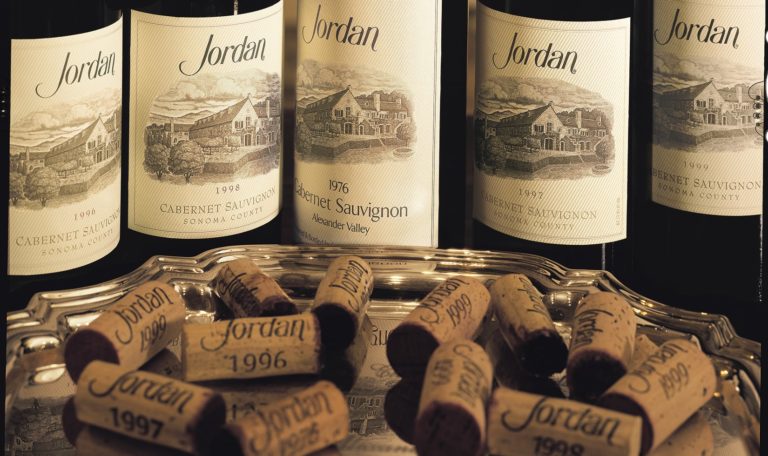In the late 1970s, California wine exploded onto the scene, propelling consumer interest to take off like a sky rocket. One lasting development of that market expansion is the head-to-head disagreement over which valley makes the best Cabernet Sauvignon: Napa Valley or Alexander Valley.
Advocates in both camps counter by asking which is better, chicken or turkey? Most people, surely most omnivores, would agree that it's a matter of personal choice. Further, the consumer is bombarded by hundreds, if not thousands, of times a day with ads and images, suggesting we make a choice. Chicken or turkey? Napa Valley or Alexander Valley?
Of course, the astute wine drinker would naturally choose both. To help inform the conundrum, I offer this examination of Alexander Valley Cabernet Sauvignon and why it has risen to the top of what many critics say is Sonoma County's best. We'll look at Napa Valley Cabernet Sauvignon in a future posting.

About Cabernet Sauvignon
First, a little background about Cabernet Sauvignon (Cab Sauv). For a grape that is so widely planted throughout the world, Cab Sauv is relatively new, arriving on the Bordeaux wine scene in the late 18th century. Little is known about how it got there, but thanks to DNA profiling in 1997, we now know that Cab Sauv's parents are Cabernet Franc and Sauvignon Blanc, both of which appear, fleetingly at times, in the aroma and taste of Cabernet Sauvignon.
Cab Sauv is a vigorous variety that needs to be restrained to avoid over-cropping. An advantage for both the grower and winemaker is that Cab Sauv ripens slowly, after Cab Franc and Merlot, the two grapes most often used with Cab Sauv in the Bordeaux blend. Cab Sauv likes warmth and doesn't ripen as well in cooler climates, tending to develop green, vegetative notes.
At ripeness, the taste of Cab Sauv is black fruits like blackberry and black currant. Mature Cab Sauv shows more complex fruit and berry with, and this depends on your sensitivities and perception, pencil shavings and/or cigar box. Alexander Valley Cab Sauv fruit is sweeter than Bordeaux and the grape's natural acidity is often hidden behind the more forward fruit.
Alexander Valley Cabernet Sauvignon
The history of Cabernet Sauvignon in the Alexander Valley really took off in the years after Prohibition was repealed in 1933. Prunes and hops were major crops in the early years, but wine grapes eventually took hold, slowly at first. Then new vineyards moved to the bench lands and Cabernet Sauvignon became the leading variety in the valley.
Revolutionary
may be too strong a word to describe the comments heard amongst
California wine makers when the 1976 Jordan Cabernet Sauvignon was released, but they became aware of this new style of California Cabernet
Sauvignon. The Jordan release also made it clear that Alexander Valley
was now a serious challenge to Napa Valley for the Cabernet crown.
A
lot has changed in the last 50 years with Alexander Valley Cabernet
Sauvignon. Planted acreage has increased and there are more wineries
now than ever making Cab Sauv. Throughout the 1970s, Cabernet was
planted mainly on flat lands, but as prime land became scarce, new
vineyards took root in the low rounded hills surrounding the valley.
Today,
there are 30 wineries in the Alexander Valley, running east of US 101,
from just south of Cloverdale to outside Healdsburg. The valley has the
warmest daytime temperatures in Sonoma County, an ideal condition for
warmth loving Cabernet Sauvignon.
 |
| Courtesy Jordan Winery |
An aside: Wine fans remember the occasion when their wine knowledge moved up a notch. For me, the date was sometime in the late 1970s. Exact years are hard to pin down, the older I get. But I was at the Jordan Winery, in the Alexander Valley, about to have my first taste of an Alexander Valley Cabernet Sauvignon.
The French inspired Jordan Winery is tucked back out of sight on a hill, off Alexander Valley Road. As we drove up the narrow winding lane, Jordan's then director of national sales, Mel Master, explained to me that Tom Jordan is interested in hearing some outside comments about the Jordan 1976 Alexander Valley Cabernet Sauvignon, before it's released.
Seated at the table in the grand dining room, as the Cabernet was being poured, I remembered Jordan telling me in an interview in his Denver office, that he and his wife, Sally are Francophiles, with a particular preference for the wines of Bordeaux.
With the first sip, I was struck with how non-California the wine smelled and tasted. Being used to the riper, more fruit-forward style of North Coast Cab Sauvs, I was not prepared for the restrained, tightly-packed fruit flavors of the '76 Jordan. Still, it had everything you'd want in a well-made Cabernet Sauvignon.
The admiration for things French aside, Jordan wines are distinctly Californian. The Jordan Cabernet Sauvignon is one expression of Alexander Valley and by extension, California. Jordan Cab Sauv remains one of Alexander Valley's best.
Here are eight more Alexander Valley wineries making impressive Cabernet Sauvignon from Alexander Valley grapes: Stonestreet, Alexander Valley Vineyards, DeLorimier Winery, Soda Creek Winery, Silver Oak Cellars, Francis Ford Coppola Winery, Trentadue Winery, Robert Young Estate Winery.
Next time you're shopping for California Cabernet Sauvignon, remember Alexander Valley.
Next post: The First Blush of Summer
Write me at boydvino707@gmail.com
No comments:
Post a Comment
Note: Only a member of this blog may post a comment.